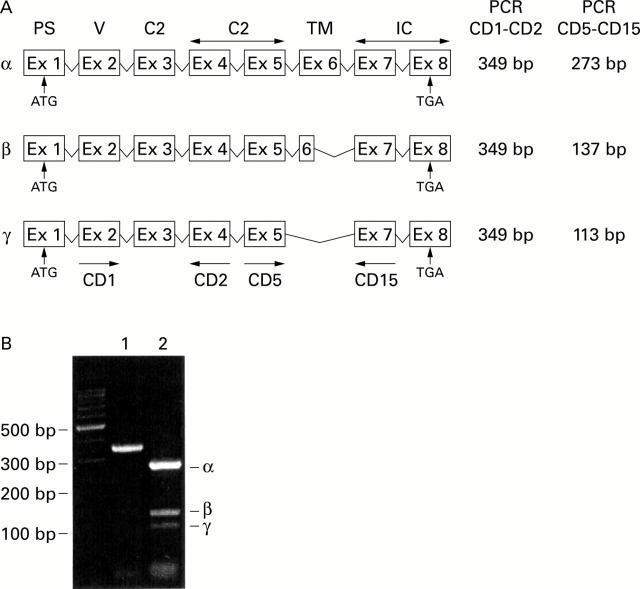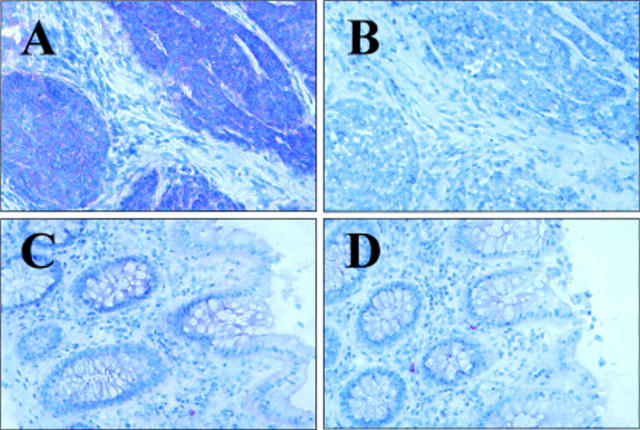Abstract
BACKGROUND AND AIMS—The Tage4 gene (tumour associated glycoprotein E4) is overexpressed in rat colon tumours and Min mouse intestinal adenomas. The rat Tage4 protein has approximately 40% identity with human CD155, a member of the immunoglobulin superfamily coding for a transmembrane protein capable of serving as an entry receptor for poliovirus, porcine pseudorabies virus, and bovine herpesvirus 1. Analysis of the rat Tage4 gene has revealed structural and functional similarities with the human CD155 gene. We therefore investigated expression of the CD155 gene in human colorectal carcinomas. METHODS—Overall CD155 expression was assessed by semiquantitative reverse transcription-polymerase chain reaction (RT-PCR) and immunohistochemical analysis using tissue specimens from patients with colorectal adenomas and adenocarcinomas. We also used a qualitative RT-PCR assay to determine relative expression of different splicing variants in each sample. RESULTS—mRNA levels of CD155 were increased in six of six colorectal cancer tissues compared with the tumour free colon mucosa. Immunohistochemical analysis revealed an increased level of CD155 protein in 12 of 12 samples. The qualitative RT-PCR assay revealed that relative expression of the different CD155 variant transcripts was similar in the different normal and cancer samples tested, indicating that this overexpression is not associated with a particular mRNA variant generated by alternative splicing of the CD155 gene. CONCLUSION—We have shown for the first time that the CD155 gene is overexpressed in colorectal carcinoma and that this overexpression begins at an early stage in tumorigenesis and continues to late stages. Keywords: CD155; colorectal cancer; immunoglobulin superfamily; poliovirus receptor
Full Text
The Full Text of this article is available as a PDF (196.2 KB).
Figure 1 .
Overview of the different CD155 transcripts and localisation of the oligonucleotides used for reverse transcription-polymerase chain reaction (RT-PCR) analysis. (A) Exon/intron organisation of the CD155 gene. Oligonucleotides CD1 and CD2, used to quantify expression of the CD155 gene, are located in a region corresponding to the extracellular domain of the protein which is conserved in all splice variants. Primers CD5 and CD15, used for qualitative analysis of CD155 expression, are located on each side of the different splice sites. Part of intron 6 is missing in variant β. The entire exon 6 is missing from variant γ. The predicted size of the different amplicons is indicated. (B) Agarose gel electrophoresis of CD155 transcripts amplified by RT-PCR from SW1116 colon cancer cells. Amplification was performed with oligonucleotides CD1 and CD2 (lane 1) or CD5 and CD15 (lane 2). No DNA was amplified when the reverse transcription was performed in the absence of reverse transcriptase.
Figure 2 .
Increased levels of CD155 in human colorectal carcinoma. Reverse transcription-polymerase chain reaction analysis of CD155 expression was performed on paired tumorous (lanes T) and non-tumorous (lanes N) colorectal tissues from four patients, as described in materials and methods.
Figure 3 .
CD155 is overexpressed in malignant epithelial cells in colorectal carcinoma. (A) Colon adenocarcinoma shows immunoreactivity with monoclonal antibody D171 (×200). (B) Adjacent section stained with an irrelevant monoclonal antibody (×200). (C) Normal colonic tissue showing barely detectable CD155 immunoreactivity (×200). (D) Normal section stained with an irrelevant monoclonal antibody (×200).
Selected References
These references are in PubMed. This may not be the complete list of references from this article.
- Baury B., Geraghty R. J., Masson D., Lustenberger P., Spear P. G., Denis M. G. Organization of the rat Tage4 gene and herpesvirus entry activity of the encoded protein. Gene. 2001 Mar 7;265(1-2):185–194. doi: 10.1016/s0378-1119(01)00343-2. [DOI] [PubMed] [Google Scholar]
- Bernhardt G., Bibb J. A., Bradley J., Wimmer E. Molecular characterization of the cellular receptor for poliovirus. Virology. 1994 Feb 15;199(1):105–113. doi: 10.1006/viro.1994.1102. [DOI] [PubMed] [Google Scholar]
- Campbell I. G., Foulkes W. D., Senger G., Trowsdale J., Garin-Chesa P., Rettig W. J. Molecular cloning of the B-CAM cell surface glycoprotein of epithelial cancers: a novel member of the immunoglobulin superfamily. Cancer Res. 1994 Nov 15;54(22):5761–5765. [PubMed] [Google Scholar]
- Chadeneau C., Denis M. G., Blottière H. M., Grégoire M., Douillard J. Y., Meflah K. Characterization, isolation and amino terminal sequencing of a rat colon carcinoma-associated antigen. Int J Cancer. 1991 Apr 1;47(6):903–908. doi: 10.1002/ijc.2910470620. [DOI] [PubMed] [Google Scholar]
- Chadéneau C., Le Moullac B., Cornu G., Meflah K., Denis M. G. Glycosylation of a novel member of the immunoglobulin gene superfamily expressed in rat carcinoma cell lines. Int J Cancer. 1995 Mar 29;61(1):87–91. doi: 10.1002/ijc.2910610115. [DOI] [PubMed] [Google Scholar]
- Chadéneau C., LeCabellec M., LeMoullac B., Meflah K., Denis M. G. Over-expression of a novel member of the immunoglobulin superfamily in Min mouse intestinal adenomas. Int J Cancer. 1996 Dec 11;68(6):817–821. doi: 10.1002/(SICI)1097-0215(19961211)68:6<817::AID-IJC21>3.0.CO;2-W. [DOI] [PubMed] [Google Scholar]
- Chadéneau C., LeMoullac B., Denis M. G. A novel member of the immunoglobulin gene superfamily expressed in rat carcinoma cell lines. J Biol Chem. 1994 Jun 3;269(22):15601–15605. [PubMed] [Google Scholar]
- Chadéneau C., LeMoullac B., LeCabellec M., Mattei M., Meflah K., Denis M. G. Isolation and chromosomal location of mE4, a novel murine gene of the immunoglobulin superfamily. Mamm Genome. 1996 Aug;7(8):636–637. doi: 10.1007/s003359900194. [DOI] [PubMed] [Google Scholar]
- Chadéneau C., Liehr T., Rautenstrauss B., Denis M. G. The Tage4 gene maps to rat chromosome 1q22. Mamm Genome. 1997 Feb;8(2):157–158. doi: 10.1007/s003359900636. [DOI] [PubMed] [Google Scholar]
- Chi K. F., Jessup J. M., Frazier M. L. Predominant expression of mRNA coding for nonspecific cross-reacting antigen in colorectal carcinomas. Tumour Biol. 1991;12(5):298–308. doi: 10.1159/000217718. [DOI] [PubMed] [Google Scholar]
- Denis M. G. Characterization, cloning and expression of the Tage4 gene, a member of the immunoglobulin superfamily. Int J Oncol. 1998 May;12(5):997–1005. doi: 10.3892/ijo.12.5.997. [DOI] [PubMed] [Google Scholar]
- Douillard J. Y., Laborda J., Burg C., Ridge J., Levenbook I., Blottière H., Sela B., Hoffman T., Ben Ami S. Monoclonal antibodies to a rat colon carcinoma: model for monoclonal antibody therapy of solid tumors. Cancer Res. 1989 Feb 1;49(3):687–692. [PubMed] [Google Scholar]
- Greve J. M., Davis G., Meyer A. M., Forte C. P., Yost S. C., Marlor C. W., Kamarck M. E., McClelland A. The major human rhinovirus receptor is ICAM-1. Cell. 1989 Mar 10;56(5):839–847. doi: 10.1016/0092-8674(89)90688-0. [DOI] [PubMed] [Google Scholar]
- Gromeier M., Lachmann S., Rosenfeld M. R., Gutin P. H., Wimmer E. Intergeneric poliovirus recombinants for the treatment of malignant glioma. Proc Natl Acad Sci U S A. 2000 Jun 6;97(12):6803–6808. doi: 10.1073/pnas.97.12.6803. [DOI] [PMC free article] [PubMed] [Google Scholar]
- Jarry A., Vallette G., Cassagnau E., Moreau A., Bou-Hanna C., Lemarre P., Letessier E., Le Neel J. C., Galmiche J. P., Laboisse C. L. Interleukin 1 and interleukin 1beta converting enzyme (caspase 1) expression in the human colonic epithelial barrier. Caspase 1 downregulation in colon cancer. Gut. 1999 Aug;45(2):246–251. doi: 10.1136/gut.45.2.246. [DOI] [PMC free article] [PubMed] [Google Scholar]
- Johnson J. P., Stade B. G., Holzmann B., Schwäble W., Riethmüller G. De novo expression of intercellular-adhesion molecule 1 in melanoma correlates with increased risk of metastasis. Proc Natl Acad Sci U S A. 1989 Jan;86(2):641–644. doi: 10.1073/pnas.86.2.641. [DOI] [PMC free article] [PubMed] [Google Scholar]
- Koike S., Horie H., Ise I., Okitsu A., Yoshida M., Iizuka N., Takeuchi K., Takegami T., Nomoto A. The poliovirus receptor protein is produced both as membrane-bound and secreted forms. EMBO J. 1990 Oct;9(10):3217–3224. doi: 10.1002/j.1460-2075.1990.tb07520.x. [DOI] [PMC free article] [PubMed] [Google Scholar]
- Lehmann J. M., Riethmüller G., Johnson J. P. MUC18, a marker of tumor progression in human melanoma, shows sequence similarity to the neural cell adhesion molecules of the immunoglobulin superfamily. Proc Natl Acad Sci U S A. 1989 Dec;86(24):9891–9895. doi: 10.1073/pnas.86.24.9891. [DOI] [PMC free article] [PubMed] [Google Scholar]
- Lopez M., Aoubala M., Jordier F., Isnardon D., Gomez S., Dubreuil P. The human poliovirus receptor related 2 protein is a new hematopoietic/endothelial homophilic adhesion molecule. Blood. 1998 Dec 15;92(12):4602–4611. [PubMed] [Google Scholar]
- Mafune K., Saini K. S., Ravikumar T. S., Chen L. B., Steele G. D., Jr, Thomas P. Differences in messenger RNA expression of carcinoembryonic antigen in surgical specimens of colorectal carcinoma. Tumour Biol. 1992;13(5-6):330–337. doi: 10.1159/000217783. [DOI] [PubMed] [Google Scholar]
- Mendelsohn C. L., Wimmer E., Racaniello V. R. Cellular receptor for poliovirus: molecular cloning, nucleotide sequence, and expression of a new member of the immunoglobulin superfamily. Cell. 1989 Mar 10;56(5):855–865. doi: 10.1016/0092-8674(89)90690-9. [DOI] [PubMed] [Google Scholar]
- Nobis P., Zibirre R., Meyer G., Kühne J., Warnecke G., Koch G. Production of a monoclonal antibody against an epitope on HeLa cells that is the functional poliovirus binding site. J Gen Virol. 1985 Dec;66(Pt 12):2563–2569. doi: 10.1099/0022-1317-66-12-2563. [DOI] [PubMed] [Google Scholar]
- Satoh-Horikawa K., Nakanishi H., Takahashi K., Miyahara M., Nishimura M., Tachibana K., Mizoguchi A., Takai Y. Nectin-3, a new member of immunoglobulin-like cell adhesion molecules that shows homophilic and heterophilic cell-cell adhesion activities. J Biol Chem. 2000 Apr 7;275(14):10291–10299. doi: 10.1074/jbc.275.14.10291. [DOI] [PubMed] [Google Scholar]
- Solecki D., Schwarz S., Wimmer E., Lipp M., Bernhardt G. The promoters for human and monkey poliovirus receptors. Requirements for basic and cell type-specific activity. J Biol Chem. 1997 Feb 28;272(9):5579–5586. doi: 10.1074/jbc.272.9.5579. [DOI] [PubMed] [Google Scholar]
- Solecki D., Wimmer E., Lipp M., Bernhardt G. Identification and characterization of the cis-acting elements of the human CD155 gene core promoter. J Biol Chem. 1999 Jan 15;274(3):1791–1800. doi: 10.1074/jbc.274.3.1791. [DOI] [PubMed] [Google Scholar]
- Staunton D. E., Merluzzi V. J., Rothlein R., Barton R., Marlin S. D., Springer T. A. A cell adhesion molecule, ICAM-1, is the major surface receptor for rhinoviruses. Cell. 1989 Mar 10;56(5):849–853. doi: 10.1016/0092-8674(89)90689-2. [DOI] [PubMed] [Google Scholar]
- Takahashi K., Nakanishi H., Miyahara M., Mandai K., Satoh K., Satoh A., Nishioka H., Aoki J., Nomoto A., Mizoguchi A. Nectin/PRR: an immunoglobulin-like cell adhesion molecule recruited to cadherin-based adherens junctions through interaction with Afadin, a PDZ domain-containing protein. J Cell Biol. 1999 May 3;145(3):539–549. doi: 10.1083/jcb.145.3.539. [DOI] [PMC free article] [PubMed] [Google Scholar]
- White J. M., Littman D. R. Viral receptors of the immunoglobulin superfamily. Cell. 1989 Mar 10;56(5):725–728. doi: 10.1016/0092-8674(89)90674-0. [DOI] [PubMed] [Google Scholar]
- Williams A. F., Barclay A. N. The immunoglobulin superfamily--domains for cell surface recognition. Annu Rev Immunol. 1988;6:381–405. doi: 10.1146/annurev.iy.06.040188.002121. [DOI] [PubMed] [Google Scholar]





